The Greenpeace Foundation
Monk Seal Campaign
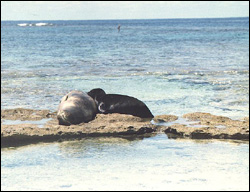
On a remote north pacific atoll, a mother monk seal nurses her single pup.
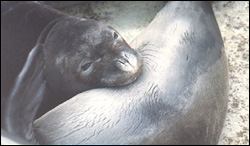
A Monk Seal mother and Pup.
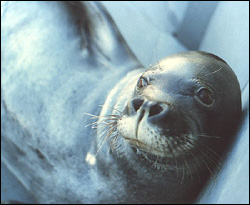
Kiss this baby-molester goodbye. It’s off to Johnston Atoll for him.

Even when humans don’t directly invade the monk seals’ remote islands, mankind’s debris often kills them.
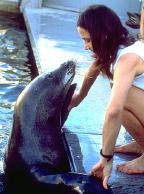
GPF President Sue White, training a wild monk seal twice her size to aid in medical testing.
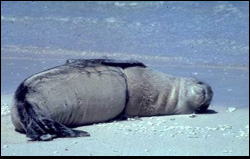
Adult monk seal badly entangled in marine debris monkseal2.jpg caption: An endangered genus, Monk seals can only survive where they don’t have to compete with man for food and space. Greenpeace Foundation
MONK SEAL CAMPAIGN MISSION
To prevent the extinction of the Monk Seal.
The most endangered seal species on earth – actually an endangered genus – is the Monk Seal. All global populations are now considered extinct except for fragile populations based on remote isles in the North Pacific and in caves in the Mediterranean. Although living in remote areas, their populations have been brought to the threshold of extinction by man’s activities. We’re working to help them survive.
One of the most endangered seal species on earth is the Hawaiian Monk Seal. Although living primarily in remote areas the Hawaiian monk seal, like its relatives the Mediterranean monk seal which lives in caves and the Caribbean monk seals which has not been since since 1952, its population has been brought to the threshold of extinction by man’s activities. We’re working to help them survive. Please join us in this effort.
POPULATION STATUS
There are approximately 1182 Hawaiian monk seals alive today. Their population is declining by up to 4.5% every year. They are considered among the most endangered seals in the world.
ISSUE FACTS:
Hawaiian monk seals have existed for over ten million years. Three million years ago, they made their way to Hawaii. When sealers arrived the islands were teeming with seals. Now fewer than 1200 are believed to exist. Now they are among the most highly endangered seal populations in the world and their number are declining at a minimum of 3% per year overall and up to 4.5% in some areas.
Tragically they could become extinct in the near future not only from direct human activities, but also from the effects of human-caused rising seas and ocean acidification.
GREENPEACE FOUNDATION IMPACT
Our campaign for this highly endangered seal species has been going on for more than 35 years, and in that time the situation of the seals has gone from “seemingly hopeless” to “they have a chance”.
GPF is working to improve fishery management plans and encourage sustainable uses of ocean resources. One example is that longline vessels are prohibited within 50 nm of the NWHI, a regulation that GPHI, along with other like-minded organizations pushed for and is now law. We also are offering a reward to encourage documentation and prosecution of people doing harm to Monk Seals.
Central to the Hawaiian monk seals’ survival has been GPF president Sue White, who has often led the fight to confront one danger after another to the seals’ survival. These dangers are noted below and we encourage you to get involved so that the seals may thrive.
With your help we can continue to advocate for the future survival of these wonderful, charismatic very special seal.
Help us to help them! An ocean without monk seals will be an empty ocean indeed!
BACKGROUND
The only remaining pacific population of Hawaiian Monk Seals exists primarily on scattered North Pacific islands. The current best estimate” by the NMFS is 1209 seals and their minimum estimate is 1182. (source: Draft Stock Assessment Report, Hawaiian Monk Seal, NMFS 2014)
The Hawaiian Monk Seal was reclassified into a new genus in 2015. Its latin name is now Neomoanchus schauinslandi. It lives a solitary life at sea eating fish, lobster, and other reef creatures. They coexist and compete with sharks, and many newborn pups quickly become shark food. Monk seals spend almost their entire lives at sea; and their secrets about these lives are still their own. Although they are increasingly found on the Main Hawaiian Islands, they are usually only encountered by humans when they haul out of the water to rest on a beach, or when they give birth on several small Pacific islands. Monk seal mothers give birth to a single pup which is heavily fed on its mother’s rich milk and then abandoned to discover the world on its own.
WHY THEY ARE SO VULNERABLE
Monk seals are a very old species, going back over 10 million years. They thrived in a pristine environment with few to no predators. They never had to develop resiliency to climate, predator or changes in prey abundance. And so they did not. This species simply does not have the ability to adapt to changing ocean and other environmental conditions.
We must all band together to work for solutions to stopping mankind from destroying the marine home of these very endangered and fragile seals.
POPULATION TREND: DECLINING
At last count, the National Marine Fisheries Service estimated the population of monk seals at 1182, They estimate that the population is declining by up to 4.5% every year in certain areas and 3% overall. They are considered among the most endangered seals in the world.
Sadly, due to a lack of prey species for food, young seals in the remote NWHI are simply not getting enough to eat. The young seals are not surviving to grow up and reproduce. And those that do face many challenges.
On the Main Hawaiian Islands, where approximately 113 seals live, the seals have slowly begun to build up their populations Encouragingly, the very small populations that are becoming established on the Main Hawaiian Island are increasing by about 6.5% per year but this slight increase in actual numbers of breeding seals simply cannot make up for the precipitous decline of the primary population in the NWHI.
The overall population decline is estimated to be between 3% per year with declines as high as 4.5% at certain NWHI atolls. (source: Draft Stock Assessment Report, Hawaiian Monk Seal, NMFS 2014)
HUMAN IMPACTS: 1800’S – 1900’S
The Hawaiian monk seal declines are believed to have begun during the 1800’s and early 1900’s with the arrival of sealers, feather hunters, guano diggers and shipwrecked crews. So many seals were killed or so disturbed that their numbers were greatly reduced. The population was pretty much left alone between 1912 until the beginning of World War II. But a steady decline began with the advent of military activity during and after the war. Population counts in the mid-1970’s indicated that populations had declined by more than half since they were counted in 1957-58, and they have not recovered substantially to this day.
THREATS TO THEIR SURVIVAL TODAY
Near Term Threats: Dwindling Prey Species
The most significant near-term threat is the dwindling populations of their prey species. While all the causes are not known it is probable that this is happening due to changes in oceanographic conditions as a result of man-caused climate change, impacts from fisheries both past and present, and competition from other predators who are also struggling to survive these changes.
In addition to needing to restore the abundance of food resources, the near-term survival of the Hawaiian monk seal depends upon increasing government funding for activities under the NMFS monk seal recovery plan; keeping the longline vessels away from the seal’s main populations; stopping fishermen from killing them at sea and preventing the killing and harassment of seals which try to repopulate the Main Hawaiian Islands. Towards this last end, Greenpeace Foundation has launched a “reward” program for the public, to encourage documentation and prosecution of people doing harm to Monk Seals.
HUMAN IMPACTS: MERE PRESENCE OF HUMANS
The Caribbean monk seals have not been seen since the early 1950’s and are thought to be extinct. The Mediterranean monk seals are now hiding out in isolated caves away from heavily populated areas. In all likelihood, the populations of monk seals in Hawaii were never large to begin with; making them particularly susceptible to outside impacts. Even in the best of times, these seals exist precariously in balance with nature. These, unfortunately, are not the best of times.
Monk seals are extremely vulnerable to human presence. When left alone, these seals bear their pups on beaches with gentle inclines into the sea. But when humans move into or even just visit their birthing areas, they may abandon them the next year, not returning to this gentle area but instead seek out more remote areas that don’t have gentle slopes and this their pups are forced to jump into deep water where they face many dangers, including being eaten by sharks. This is a direct cause in the decline of all monk seals species.
HUMAN IMPACT RESULT: SKEWED SEX RATIOS
The mere presence of humans in their ancestral breeding islands is an insidious pressure on monk seal populations. Seals will often leave an area if humans are seen; but there are few places they can go to reproduce. Possibly due to the females being more likely to leave when intruded upon – and thus subjected to greater pressure from sharks, active nets, and underwater marine debris – there are now skewed sex ratios on several of the key islands. This means there are a lot more male seals than females. This is a bigger problem than even it might seem.
Obviously, only female seals can have pups; and their low reproductive rate and high infant mortality contribute to a difficulty in rebuilding population size. But the sex drive of some male monk seals is so strong that a few go virtually berserk with too few females to mate with; gang-raping females and newborn pups to death . It isn’t pretty, and it’s important to remember that this aberrant behavior is apparently in response to a human-caused unnatural decline in female seals.
From 1984 -1998, the National Marine Fisheries Service adopted a program – which we supported – of relocating identified sex-offender seals to places like Johnston Atoll, where no females were known to exist. This seems to have helped and is a commentary on just how many things can go wrong when humans impact natural systems which were already in delicate balance.
We strongly support an increase in funding so that the NMFS can continue to monitor and if necessary reinstate the removal of aberrant males.
HUMAN IMPACT: AT SEA FISHERIES- INTENTIONAL KILL ING OF SEALS
A more direct threat has been the intentional killing of adult monk seals by longline and other fishing vessels which stray in too close to their breeding islands, primarily the remote atolls of the Northwestern Hawaiian Islands. Longline vessels have been reported shooting and clubbing hooked monk seals. For that reason, this organization and others have worked to keep longline boats farther offshore. This has ameliorated the problem somewhat, but there is seldom an enforcement presence on site. Moreover, some of the longline vessel captains and crews have reportedly been utter jerks, shooting seabirds with skeet guns for fun; so this remains an uneasy situation. There has also been a conflict with human lobster fishermen who attempt to compete directly with Monk Seals for a common food supply. Anecdotal accounts indicate that when such conflicts occur, humans are more likely to be carrying guns than seals are, and the seals lose.
HUMAN IMPACT: KILLING OF SEALS IN THE MAIN HAWAIIAN ISLANDS:
In an encouraging sign, monk seals are now being sporadically spotted on the main Hawaiian islands, and the hope is that they will return to these islands where they are believed to have once lived in much greater numbers. However, human harassment and killing of these seals, when they do show up, could keep this from happening. A female monk seal was killed and eaten by a Kauai resident and in March ’99 Greenpeace Foundation obtained tape shot by independent videographer David Jordan of an individual on Maui hitting a resting seal with coconuts and rocks. In recent years, on-shore fishermen have killed several monk seals including pups and a pregnant mom so the effort continues.
GREENPEACE OUTREACH AND REWARD PROGRAM – MAIN HAWAIIAN ISLANDS
Greenpeace Foundation started a public outreach and reward program to encourage people to respect the monk seals, and document the actions of harassers for prosecution.
These seals have lived for 15 million years virtually unchanged; let’s make sure they survive into the future.
HUMAN IMPACT: INDIRECT: MARINE DEBRIS ENTANGLEMENTS
In recent years their populations have suffered extreme impacts from marine debris and washed-up nets which have taken a huge toll of baby seals. Their remote island beaches are literally strewn with the detritus of mankind: nets, plastic strapping, bags, floats, etc.
CRITICAL HABITAT EXPANDED in 2015!
Now We have to work hard to make sure that this is a good thing for the seals!
Greenpeace Foundation proudly takes credit for the initial critical habitat designation in 1988 which was a result of a GPF lawsuit against the NMFS. Critical habitat requires that all actions of agencies in the designated areas be reviewed to see if they will have an impact on the seals. While CH does not affect actions of the public, it spotlights the need for protective measures and often inspires additional protective measures.
Since 1988 other organizations have built up on GPF’s success and won a victory for the seals in 2015 with the expansion of the CH to include the Main Hawaiian Islands!
While we are proud to have set the ground work for this expanded habitat, we are also concerned. With this CH designation comes great responsibility by the NMFS and those who proposed and advocated for it to ensure that seals are not killed as a result.
There is a small but vocal faction of fishermen who do not understand that CH does NOT stop them from fishing in the MHI and that the seals are NOT the reason that fish stocks are declining around the state. Sadly, this is not intuitive to many and we fear that seals will bear the tragic brunt of this misunderstanding.
Recent studies of the diets and diving behaviors of Hawaiian monk seals reveal that they are not and never have been a significant competitor of subsistence fishermen. Any yet many seals have lost their lives due to this misunderstanding.
Sadly, several seals have been killed by humans on or near beaches on the Main Hawaiian Islands. A young female, for example, was bashed in the head on November 30, 2014. RF58 was only 5 months old when she died and with her died the hope that she would have many pups in her future and would help her species to recover. She was the 5th monk seal to be killed by humans since 2011. So sad. So unnecessary.
We strongly urge you to contact the NMFS and encourage them to form coalitions with fishers, native Hawaiian groups, conservation organizations, property owners and others to ensure that seals hauling out around the MWHI are treasured rather than seen as an unwanted competitors for Hawaii’s fisheries resources.
******* THE ULTIMATE THREAT**********
Long-Term Threats: Extinction due to Climate Disruption
In the long-term, if climate disruption (commonly known by the more benign sounding term “climate change”) is not stopped, rising sea-levels will cover pupping and hauling out areas. Equally serious, is that ocean acidification (a result of C02 in the atmosphere falling into the oceans) kills coral reef and other marine ecosystems. Without the reefs, the monk seals are doomed. Learn more about the GPF acidification campaign.
Oceans without monk seals will be very empty.
HOW YOU CAN HELP!
Contribute to the GreenPeaceFoundation Seal Campaign.
* Help educate fishermen
* Work to Stop C02 emissions
* Document harassment or kills, on shore or aboard boats! You may qualify for a reward, and you’ll definitely help the seals!
Report to: emailgpfdn@gp.com phone (415) 689-9931
CONTACT NOAA
Urge NOAA to prosecute harassers and killers of monk seals to the full extent of the law.
Encourage NOAA/ NMFS to initiate state-wide educational campaigns to prevent the murder of innocently hauled out monks seals:
Office of Protected Resources
NOAA Fisheries Headquarters
1315 East-West
Highway SSMC3
Silver Springs, MD 20910
TAKE ACTION
Contribute to the GreenPeaceFoundation Seal Campaign.
Document harassment or kills, on shore or aboard boats! You may qualify for a reward, and you’ll definitely help the seals!
Report to: greenpeace@mail.com, phone 808-263-4388
Write to NOAA to urge continued funding for Monk Seal protection against fisheries pressure. Urge them to maintain longline vessel exclusion at 50 nautical miles away from the Northwestern Hawaiian Islands.
Urge NOAA to prosecute harassers and killers of monk seals to the full extent of the law.
Write to:
Office of Protected Resources
NOAA Fisheries Headquarters
1315 East-West
Highway SSMC3
Silver Springs, MD 20910
The USA’s oldest and original Greenpeace, proudly unaffiliated with Greenpeace USA


